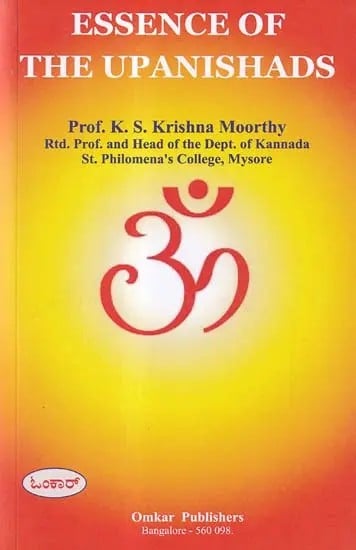
| Specifications |
| Publisher: Omkar Publishers, Bangalore | |
| Author K. S. Krishna Moorthy | |
| Language: English and Sanskrit | |
| Pages: 276 | |
| Cover: PAPERBACK | |
| 8.5x5.5 inch | |
| Weight 310 gm | |
| Edition: 2023 | |
| HAZ539 |
| Delivery and Return Policies |
| Ships in 1-3 days | |
| Returns and Exchanges accepted within 7 days | |
| Free Delivery |
Prof. K. S. Krishna Moorthy, the author of 'Essence of the Upanishads' was Professor and head of the Dept. of Kannada in St. Philomena's College, Mysore affiliated to the University of Mysore. He was a very popular teacher endeared by his students. He is the author of many books in Kannada. Kumara Valmiki's Toraveya Ramayana published by Kannada Sahitya Parishat, Toraveya Narahari, Choundarasa, Sanketi Sampada, and Virataparva Sangrahada Kaigannadi are some of his books in Kannada.
He has translated Valentine's Katayev's well-known Russian novels 'white sail gleams" and "cottage on the steppe' as well as "A century of Indian Womanhood' by Prof. S. Sridevi into Kannada. Critical and literary essays on Kannada and Sanskrit literature written by him have appeared in various magazines and commemoration volumes. This is his first book in English language.
In this book the author has tried to bring out the philosophy of the Upanishads, keeping with the central idea running through the principal Upanishads. The author has given due importance to the teacher student relationship as depicted in the Upanishads in contrast with the present day education system. The development of the individual and relationship between the individual self, the Atma and the Cosmic soul, Brahma has been brought out in simple language.
Upanishads are many and many have written on Upanishads. Many more will be writing too. To the seekers of TRUTH Upanishads one becon lights. 'Let everything go but let Isavasya Upanishad remain, our country will again rise its head' said Gandhiji. That is the strength of the Upanishads. Upanishads, the contents of the Upanishads is called Vedanta. Vedanta is the essence of the VEDA. VEDA means treasure house of knowledge. To study the VEDA, the ocean of knowledge, is not possible.
Hence, it is the gift of our Rishis of the past to us in the form of the upanishads. Upanishads are many in number, over one hundred and ten. But among them twelve are very popular. Isavasya, Aitareya, Kausheetaki, Katha, Kena, Mumdaka, Mandukya, Prashna, Taittiriya, Chandogya, Swetashwatara and Brihadaranyaka. Upanishads' roots are from different branches of Veda Rig Yajus Sama Atharva - There are some from Aranyakas and Brahmanas.
Each Upanishad commences with a Shantimantra - Peace Invocation. These peace invocations are like capsules - containing the essence of the Upanishads! The one such, the most popular one says "From the unreal lead me to the Real, from darkness lead me to light, from death lead me to immortality.
The Upanishads are the ancient philosophical books of India wherein the truth as revealed to the ancient seers is recorded. The Upanishads occupy a unique place in the ancient Sanskrit literature. Upanishads come after the Vedas which are the most ancient and sacred books of India. In order to understand the importance of the Upanishads it becomes necessary to acquaint ourselves about the nature and contents of Vedas in brief at least.
The word Veda signifies knowledge. There are four Vedas namely the Rgveda, the Yajurveda, the Samaveda and the Atharva Veda. In the literary history of India the age of the Vedas is known as the Vedic period. Many scholars are of the opinion that the Vedic period ranges from 1500 B.C. to 2000 B.C. But scholars differ in their opinions. Some scholars put back the time prior to 2000 B.C. certain other scholars including Indian scholars date the Vedas far beyond 2000 B.C., stretching up to eight thousand before Christ.
The Vedas are the outcome of a creative and poetic age in which hymns and prayers were composed to sing at the time of performing sacrifices wherein Soma juice and clarified butter were offered to Gods. The four Vedas are collections of hymns and prayers made for different ritual purposes.
Send as free online greeting card

Visual Search